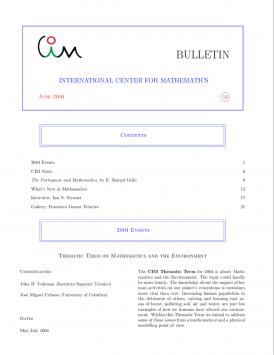2004 Events
1-5
- 3-8 May: School and Workshop on Dynamical Systems and Applications
- June 3 - 5: Workshop on Forest Fires
- July 12 - 16: School on Atmospheric Sciences and Climate Dynamics
- July 19-24: Summer School and Workshop on Oceanography, Lakes and River
CIM News
6-7
CIM Governing Bodies for 2004-2008
The CIM General Assembly, in a meeting held in Coimbra on May 29, elected the CIM Governing Bodies for the next four years:
Executive Board
Joaquim Júdice, Univ. Coimbra (President) Ivette Gomes, Univ. Lisbon
Filomena Almeida, Univ. Porto
Domingos Cardoso, Univ. Aveiro
José Miguel Urbano, Univ. Coimbra
General Assembly
António Guedes de Oliveira, Univ. Porto, (Chair) Fátima Martins, New Univ. Lisbon (Secretary) António Ornelas, Univ. Évora (Secretary) Auditing Board
Joana Soares, Univ. Minho (Chair) Rafael Brigham, Univ. Algarve Carlos Alves, Tech. Univ. Lisbon
The Portuguese and Mathematics
E. Marçal Grilo
8-11
If we wish to analyse any matter, global or special, about Education in Portugal, we must begin by describing realistically the features of the country in what concerns the skills and qualifications of its population.
DNA does the twist. And the writhe. A “News and Views” item in the May 13 2004 Nature picked up a preprint posted by Maria Barbi, Julien Mozziconacci and Jean-Marc Victor, all with the CNRS. “In the cells of higher eukaryotes, e.g. animals or plants, meters of DNA are packaged by means of proteins into a nucleus of a few micrometer diameter, providing an extreme level of compaction.” As we know, the nuclear DNA contains a library with all the instructions for making and maintaining a cell. But how does one access an item in a library where all the text is on a single line miles long bunched up into a volume inches in diameter? We know there are enzymes (topoisomerases) that allow one strand of DNA to pass through another, so there is no topological obstruction to moving any particular segment of DNA to where it may be copied. But tran- scription can take place without topoisomerases. How? Barbi and collaborators studied the way that DNA is coiled. The first two levels of packing result in a chro- matin fiber.
Ian N. Stewart
Jorge Buescu
17-20
You started out as a group theorist in the early 70’s, then worked on successively in Catastrophe Theory, Bifurcation Theory, Dynamical Systems and Chaos, and now are turning towards Mathematical Biology. It’s a rather remarkable trajectory. How did it come about?
Francisco Gomes Teixeira
António Leal Duarte
Maria do Céu Silva
Carlos Correia de Sá
21-23
Francisco Gomes Teixeira was born at São Cosmado, a small village near Armamar, in the North of Portugal, near the river Douro, on the 28th January 1851.
